 |
Koteeswara Mahadeva The small Shiva shrine known as Koteeswara Mahadeva is a little known temple in the district of Tehri. It is about twelve kilometres from the small town of Chakka which is on the by pass road to Devaprayag. It is an extraordinarily beautiful temple and reminds one of the Omkareshwara temple. The architecture is very simple but as usual the spot chosen by Shiva is a most beautiful and desolate one. The river Bhageerati which comes from Gangotri gushes her way down the valley to this spot. Here she makes a loop and circumambulates the linga of Koteeswara Mahadeva before proceeding on her way to join the Alagananda at Rudraprayag. This in itself is a remarkable phenomenon. All rivers meander their way down to the sea and they certainly do not think of tracing their way backwards. But here the Bhageerati does exactly that. Her source is in Gangotri in the Himalayas and thus she has to proceed south in order to reach the sea but at this particular spot she makes a loop and flows quite a way to the north. Only then does she turn round and proceed on her way south. By this manoeuvre she actually does a pradakshina or circumambulation of the idol of Shiva. In all Hindu temples, devotees will always make a round of the sanctum in a clockwise manner. This is supposed to bring immense benefits, so it looks as if the river is also following this ingrained habit of all temple goers. So here she is known as uttara Ganga or the Ganga which flows north. 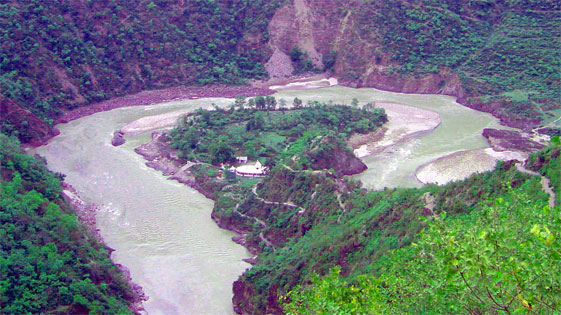 Gangotri is the place where the king sage known as Bhagheeratan practised immense austerities in order to compel the heavenly Ganga to fall on the earth and bring salvation to his ancestors. The ancients believed that the power of self discipline and self denial while concentrating on God produced a tremendous force which was capable of bending the divine forces and making them comply with the requests of the person practising this tapasya or austerity. However even though Ganga agreed to come to the earth, she was of the opinion that the earth would not be able to bear her weight and would get swept away into space. So Bhageeratan did another bout of penance to Lord Shiva who promised to break Ganga’s fall and catch her in his matted locks. However, now new problems arouse. In order to curb Ganga’s pride, Shiva enfolded her in his locks and she could not find a way to come out. She, who had thought her strength was enough to sweep away the earth, now found that she was incapable of penetrating through the dark jungle of Shiva’s hair! Once again the poor king was foiled in his attempt to bring the Ganga to the earth. But Bhageeratan was not a man to be easily beaten. His name has come to be synonymous with infinite patience and infinite self sacrifice. Once again he underwent severe penance until Shiva relented and agreed to release a small amount of the waters of the heavenly Ganga from his locks and this is the river which we see today. Her name at this point is not Ganga but Bhageerati, as a tribute to the king who had undergone superhuman trials in order to save his ancestors. In turn you find that at this point the Ganga goes out of her way in order to salute the Lord who had curbed her pride and who now cherished her forever in his locks. 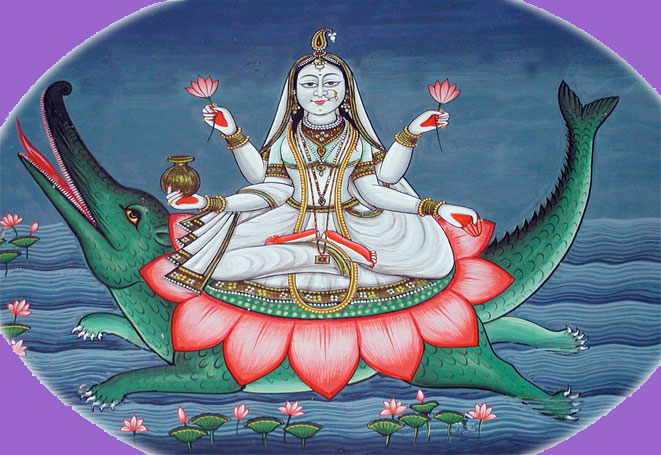 Ganga Devi The approach to this temple is through Rishikesh or Devaprayag. From Rishikesh one has to take the road leading to Chamba. When you reach the small town of Khadi one has to take a right turn into a very narrow mountain road which winds its way to the little village of Gajja which is about 64 kilometres from Rishikesh. The road from here proceeds downwards towards Devaprayag. The village of Chakka lies about 12 kilometres from Gajja. Before reaching Chakka a small road turns off from the main road to another village. One has to go along this road for about five kilometres before reaching the track which goes down to the temple of Koteeswara. From here there is a steep descent through a narrow track which leads through fields. 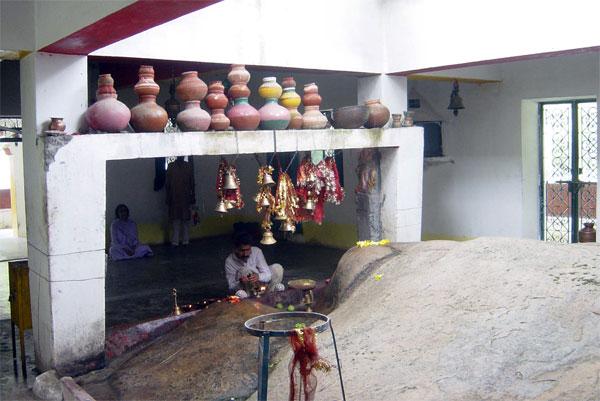 Our first view of the temple is quite breathtaking. Far below us lies the small round peninsula on which the temple is situated surrounded by the river which glints in the sunlight and dances round the temple chanting “Aum Namashivaya” all the time. The laburnum trees were all in bloom when we went and shed their golden splendour all around. The air was saturated with the perfume of a tiny white hill jasmine and the inebriated bees buzzed around in ecstasy whether at the thought of having the darshan of the Lord or because of the intoxicating perfume of the flowers, was hard to say. Having reached the temple the right thing to do is to go further down and bathe in the Bhageerati. Despite the summer heat, she is icy cold due to the melting glaciers from which she has originated. Those who are not happy about having such a cold douche can also dabble their feet and wash their hands and faces and thus get rid of some, if not all, of their impurities! Then one has to carry some of this holy water and go to the temple. The structure is a modern one and not worth looking at. But the linga inside is said to be swayambhu or self born. It is a huge stone shaped like a hump like the linga at Kedarnath. It has strange markings all over it. The usual pot containing Ganga water is suspended over it and drips continuously. This is Ganga’s way of worshipping the Lord and helping to keep him cool. Those who lose their tempers easily are asked to pour Ganga water over Shiva so that their temper is cooled. A pujari or priest will normally be seated there. He mutters the usual prayers. It is obvious that he does not know much. But we are allowed to do our own puja and worship the Lord according to our own method. It was wonderful to sit there and absorb the vibrations. 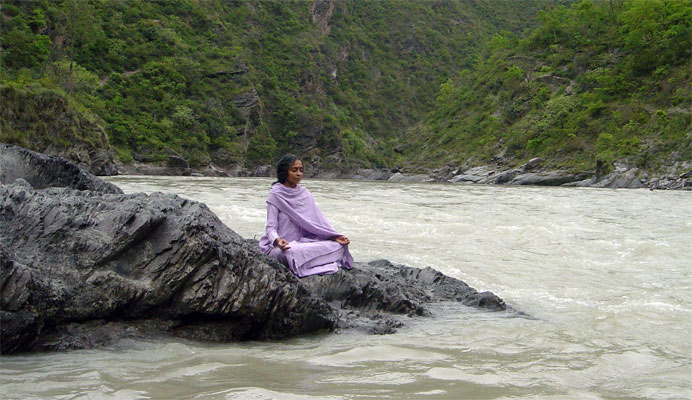 The nicest thing about this temple is that it is totally off the beaten track of the normal pilgrim so it has an untouched, pristine look. The usual rabble and crowd of hawkers and beggars are not to be found. One is alone with the music of the river and the sweet cooing of the doves and the sound of a cuckoo in the distance. The Lord rests in his favourite solitude untroubled by the pestering crowd of devotees with their infinite woes. He is wrapped in the embrace of his wife, Ganga. 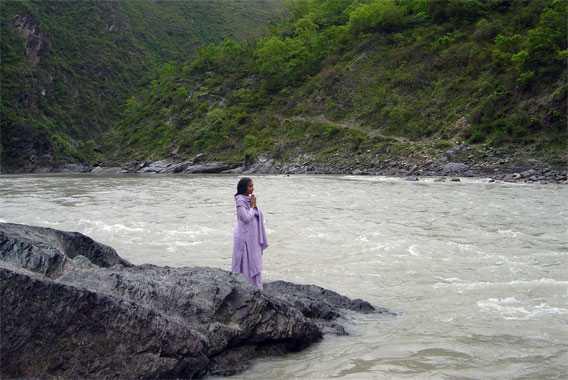 The way back is uphill and very tedious especially if the sun is hot. At least on the way down we are kept enthralled by the frequent glimpses of the temple surrounded by the river but the climb back feels longer and certainly more strenuous. However one is sustained by the exhilarating experience which one has just gone through. Aum Namashivaya |
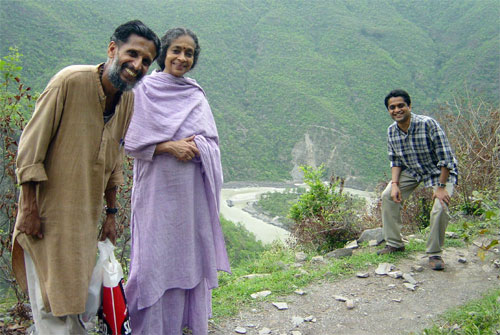 BR Mohan, Mathaji, and Janardan at Koteeswara |
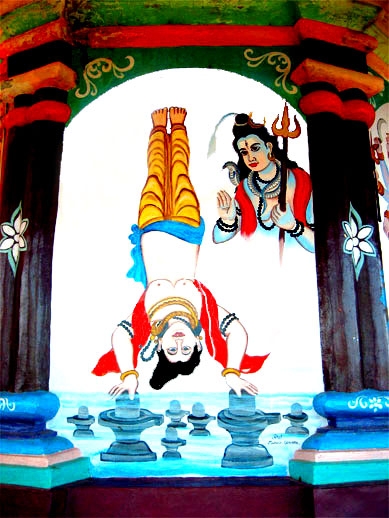 |
Tapas of Parvati |
About Vanamali Ashram |
Ashram Store |
Satsang |
Miracle at Vanamali |
Bhagavad Gita |
Home |
Sunil Baba |
Wildflower Cards |
Reason For Rebirth |
Vanamali Love Songs |
 |
||||
|



